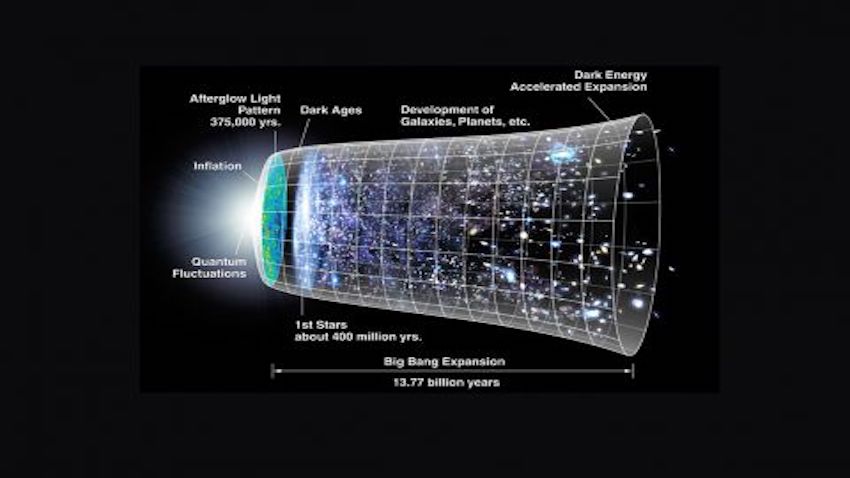A new study by researchers from the Department of Physics, from the Division of Fundamental Sciences, from the Technological Institute of Aeronautics (ITA), on the existence of a 5th dimension in the Universe, was highlighted in May in the Chinese journal of Physics, Chinese Journal of Physics, with the publication of the article “Induced Equation of State for the Universe Epochs Constrained by the Hubble Parameter”, which received a special mention from the editor of the magazine. The article, the result of the ongoing doctorate by Marcelo Lapola, under the guidance of Professor Manuel Malheiro, generalizes a model proposed in 2015 by Dr. Pedro Henrique Ribeiro da Silva Moraes, co-advisor of the current study, describes the possibility of a 5th dimension in Space, which could explain not only the generation of energy and the consequent existence of matter in the Universe, but also the origin of the dark energy responsible for its current accelerated expansion.
The work also received special attention, in June, in the Galileu magazine, one of the main vehicles of scientific dissemination in Brazil, and had the collaboration of the Head of the Division of Fundamental Sciences at ITA, Professor Wayne de Paula, and with the contribution of cosmologists Professors José Fernando de Jesus, from the Universidade Estadual Paulista (UNESP), and Rodolfo Valentim, from the Federal University of São Paulo (UNIFESP), who compared the theoretical predictions of the model with the most recent observational data of the Hubble parameter, a law that measures the acceleration of the universe's current expansion.
As Professor Malheiro explains, the research was developed considering three hypotheses: the first proposed the existence of a 5th dimension in the Universe, with an expansion rate different from the other dimensions, which expand in our homogeneous and isotropic space-time; the second worked on the association of the energy density and pressure of the Universe to terms involving the rate of expansion of the extra dimension in the components of Einstein's equation, in five dimensions; and finally, the third hypothesis assumed the existence of a constant energy density associated with the creation of a vacuum in this five-dimensional space. Based only on these three assumptions, it was possible to obtain an expression for the Hubble parameter, which measures the expansion rate of our Universe and its evolution over time, that is, from the Big Bang to current times. It was also possible to deduce a single equation for the pressure of the Universe, as a function of its energy density over time, capable of describing in a unified way the three Eras of the Universe's evolution: the Era of Radiation, very hot and with emission of high frequency electromagnetic radiation; the Age of Matter, period of formation of the Galaxies, and the current Age of Dark Energy, of accelerated expansion of the Universe. In the standard Cosmological model, each of these Ages has a different equation for the pressure and energy density of the Universe.
As a result of the research, the researchers were able to analyze the temporal evolution of the Hubble parameter, with the free constant of the model fixed by its current value, obtaining a good agreement with the observational data. All this was possible to obtain with only the three hypotheses of the model, validating the unified description of the evolution of the Universe with only one relation between the pressure and the energy density of the Universe for its three Eras. This result is unprecedented in Cosmology, as it arises only from the geometrization of the space-time structure, not considering other hypotheses, such as the existence of extra fields in the Einstein equation proposed in most models in the literature, which seek to obtain this unified description.
The next step, after such relevant discoveries, will be to understand the 5th dimension and check if it can be detected. As Professor Malheiro points out, “maybe we have not yet found it because it is too small. Another possibility that has been worked on is the fact that we were never able to detect it, as it is infinitely large and impossible to be reached, because, as we live in a four-dimensional subspace (the three spatial directions plus time), we are trapped in a subspace smaller in size than the Universe. Furthermore, we intend to explore the proposal that the energy density associated with vacuum in five-dimensional space, responsible for dark energy, is not constant as we assume, but has varied throughout the evolution of the Universe”.
If you want to access the full scientific article or the article from the Galileo magazine, click on the following links:
www.sciencedirect.com/science/article/pii/S057790732100099X (link is external)
https://revistagalileu.globo.com/Ciencia/Espaco/noticia/2021/06/estudo-d... (link is external)

